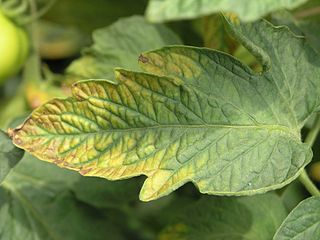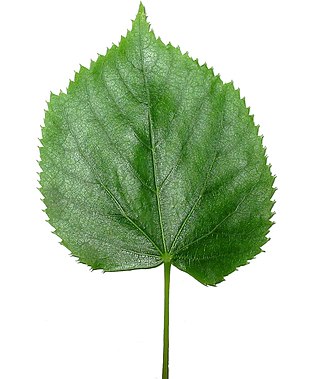
Photosynthesis is a biological process used by many cellular organisms to convert light energy into chemical energy, which is stored in organic compounds that can later be metabolized through cellular respiration to fuel the organism's activities. The term usually refers to oxygenic photosynthesis, where oxygen is produced as a byproduct, and some of the chemical energy produced is stored in carbohydrate molecules such as sugars, starch and cellulose, which are synthesized from endergonic reaction of carbon dioxide with water. Most plants, algae and cyanobacteria perform photosynthesis; such organisms are called photoautotrophs. Photosynthesis is largely responsible for producing and maintaining the oxygen content of the Earth's atmosphere, and supplies most of the biological energy necessary for complex life on Earth.

In botany, a stoma, also called a stomate, is a pore found in the epidermis of leaves, stems, and other organs, that controls the rate of gas exchange. The pore is bordered by a pair of specialized parenchyma cells known as guard cells that regulate the size of the stomatal opening.

Potassium deficiency, also known as potash deficiency, is a plant disorder that is most common on light, sandy soils, because potassium ions (K+) are highly soluble and will easily leach from soils without colloids. Potassium deficiency is also common in chalky or peaty soils with a low clay content. It is also found on heavy clays with a poor structure.

Excretion is a process in which metabolic waste is eliminated from an organism. In vertebrates this is primarily carried out by the lungs, kidneys, and skin. This is in contrast with secretion, where the substance may have specific tasks after leaving the cell. Excretion is an essential process in all forms of life. For example, in mammals, urine is expelled through the urethra, which is part of the excretory system. In unicellular organisms, waste products are discharged directly through the surface of the cell.

Gas exchange is the physical process by which gases move passively by diffusion across a surface. For example, this surface might be the air/water interface of a water body, the surface of a gas bubble in a liquid, a gas-permeable membrane, or a biological membrane that forms the boundary between an organism and its extracellular environment.

Plant nutrition is the study of the chemical elements and compounds necessary for plant growth and reproduction, plant metabolism and their external supply. In its absence the plant is unable to complete a normal life cycle, or that the element is part of some essential plant constituent or metabolite. This is in accordance with Justus von Liebig’s law of the minimum. The total essential plant nutrients include seventeen different elements: carbon, oxygen and hydrogen which are absorbed from the air, whereas other nutrients including nitrogen are typically obtained from the soil.

Photorespiration (also known as the oxidative photosynthetic carbon cycle or C2 cycle) refers to a process in plant metabolism where the enzyme RuBisCO oxygenates RuBP, wasting some of the energy produced by photosynthesis. The desired reaction is the addition of carbon dioxide to RuBP (carboxylation), a key step in the Calvin–Benson cycle, but approximately 25% of reactions by RuBisCO instead add oxygen to RuBP (oxygenation), creating a product that cannot be used within the Calvin–Benson cycle. This process lowers the efficiency of photosynthesis, potentially lowering photosynthetic output by 25% in C3 plants. Photorespiration involves a complex network of enzyme reactions that exchange metabolites between chloroplasts, leaf peroxisomes and mitochondria.

Averrhoa carambola is a species of tree in the family Oxalidaceae native to tropical Southeast Asia; it has a number of common names, including carambola, star fruit and five-corner. It is a small tree or shrub that grows 5 to 12 m tall, with rose to red-purple flowers. The flowers are small and bell-shaped, with five petals that have whitish edges. The flowers are often produced year round under tropical conditions. The tree is cultivated in tropical and semitropical regions for its edible fruits.

Hyperaemia is the increase of blood flow to different tissues in the body. It can have medical implications but is also a regulatory response, allowing change in blood supply to different tissues through vasodilation. Clinically, hyperaemia in tissues manifests as erythema because of the engorgement of vessels with oxygenated blood. Hyperaemia can also occur due to a fall in atmospheric pressure outside the body. The term comes from Greek ὑπέρ (hupér) 'over', and αἷμα (haîma) 'blood'.

The epidermis is a single layer of cells that covers the leaves, flowers, roots and stems of plants. It forms a boundary between the plant and the external environment. The epidermis serves several functions: it protects against water loss, regulates gas exchange, secretes metabolic compounds, and absorbs water and mineral nutrients. The epidermis of most leaves shows dorsoventral anatomy: the upper (adaxial) and lower (abaxial) surfaces have somewhat different construction and may serve different functions. Woody stems and some other stem structures such as potato tubers produce a secondary covering called the periderm that replaces the epidermis as the protective covering.
Moisture stress is a form of abiotic stress that occurs when the moisture of plant tissues is reduced to suboptimal levels. Water stress occurs in response to atmospheric and soil water availability when the transpiration rate exceeds the rate of water uptake by the roots and cells lose turgor pressure. Moisture stress is described by two main metrics, water potential and water content.

Guard cells are specialized plant cells in the epidermis of leaves, stems and other organs that are used to control gas exchange. They are produced in pairs with a gap between them that forms a stomatal pore. The stomatal pores are largest when water is freely available and the guard cells become turgid, and closed when water availability is critically low and the guard cells become flaccid. Photosynthesis depends on the diffusion of carbon dioxide (CO2) from the air through the stomata into the mesophyll tissues. Oxygen (O2), produced as a byproduct of photosynthesis, exits the plant via the stomata. When the stomata are open, water is lost by evaporation and must be replaced via the transpiration stream, with water taken up by the roots. Plants must balance the amount of CO2 absorbed from the air with the water loss through the stomatal pores, and this is achieved by both active and passive control of guard cell turgor pressure and stomatal pore size.

The soil-plant-atmosphere continuum (SPAC) is the pathway for water moving from soil through plants to the atmosphere. Continuum in the description highlights the continuous nature of water connection through the pathway. The low water potential of the atmosphere, and relatively higher water potential inside leaves, leads to a diffusion gradient across the stomatal pores of leaves, drawing water out of the leaves as vapour. As water vapour transpires out of the leaf, further water molecules evaporate off the surface of mesophyll cells to replace the lost molecules since water in the air inside leaves is maintained at saturation vapour pressure. Water lost at the surface of cells is replaced by water from the xylem, which due to the cohesion-tension properties of water in the xylem of plants pulls additional water molecules through the xylem from the roots toward the leaf.
A xerophyte is a species of plant that has adaptations to survive in an environment with little liquid water. Examples are typically desert regions like the Sahara, and places in the Alps or the Arctic. Popular examples of xerophytes are cacti, pineapple and some Gymnosperm plants.

Transpiration is the process of water movement through a plant and its evaporation from aerial parts, such as leaves, stems and flowers. Water is necessary for plants but only a small amount of water taken up by the roots is used for growth and metabolism. The remaining 97–99.5% is lost by transpiration and guttation. Leaf surfaces are dotted with pores called stomata, and in most plants they are more numerous on the undersides of the foliage. The stomata are bordered by guard cells and their stomatal accessory cells that open and close the pore. Transpiration occurs through the stomatal apertures, and can be thought of as a necessary "cost" associated with the opening of the stomata to allow the diffusion of carbon dioxide gas from the air for photosynthesis. Transpiration also cools plants, changes osmotic pressure of cells, and enables mass flow of mineral nutrients and water from roots to shoots. Two major factors influence the rate of water flow from the soil to the roots: the hydraulic conductivity of the soil and the magnitude of the pressure gradient through the soil. Both of these factors influence the rate of bulk flow of water moving from the roots to the stomatal pores in the leaves via the xylem.

A leaf is a principal appendage of the stem of a vascular plant, usually borne laterally aboveground and specialized for photosynthesis. Leaves are collectively called foliage, as in "autumn foliage", while the leaves, stem, flower, and fruit collectively form the shoot system. In most leaves, the primary photosynthetic tissue is the palisade mesophyll and is located on the upper side of the blade or lamina of the leaf but in some species, including the mature foliage of Eucalyptus, palisade mesophyll is present on both sides and the leaves are said to be isobilateral. Most leaves are flattened and have distinct upper (adaxial) and lower (abaxial) surfaces that differ in color, hairiness, the number of stomata, the amount and structure of epicuticular wax and other features. Leaves are mostly green in color due to the presence of a compound called chlorophyll which is essential for photosynthesis as it absorbs light energy from the sun. A leaf with lighter-colored or white patches or edges is called a variegated leaf.

Photosynthesis systems are electronic scientific instruments designed for non-destructive measurement of photosynthetic rates in the field. Photosynthesis systems are commonly used in agronomic and environmental research, as well as studies of the global carbon cycle.
Stomatal conductance, usually measured in mmol m−2 s−1 by a porometer, estimates the rate of gas exchange and transpiration through the leaf stomata as determined by the degree of stomatal aperture.
Homoiohydry is the capacity of plants to regulate, or achieve homeostasis of, cell and tissue water content. Homoiohydry evolved in land plants to a lesser or greater degree during their transition to land more than 500 million years ago, and is most highly developed in the vascular plants. It is the consequence of a suite of morphological innovations and strategies that enable plant shoots exploring aerial environments to conserve water by internalising the gas exchange surfaces, enclosing them in a waterproof membrane and providing a variable aperture control mechanism, the stomatal guard cells, which regulate the rates of water transpiration and CO2 exchange. In vascular plants, water is acquired from the soil by roots and transported via the xylem to aerial portions of the plant. Water evaporation from the aerial surfaces of the plant is controlled by a waterproof covering of cuticle. Gas exchange with the atmosphere is controlled by stomata, which can open and close to control water loss, and diffusion of carbon dioxide to the chloroplasts takes place in intercellular spaces between chlorenchyma cells in the stem or in the mesophyll tissue of the leaf.
The Bionic Leaf is a biomimetic system that gathers solar energy via photovoltaic cells that can be stored or used in a number of different functions. Bionic leaves can be composed of both synthetic and organic materials (bacteria), or solely made of synthetic materials. The Bionic Leaf has the potential to be implemented in communities, such as urbanized areas to provide clean air as well as providing needed clean energy.














